Article by Wayne Gillam Photos by Ryan Hoover | UW ECE News
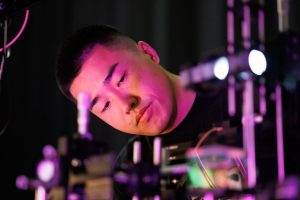
2023 Yang Award recipient Bingzhao Li is a postdoctoral research fellow in UW ECE and Physics Professor Mo Li’s UW Laboratory of Photonic Systems, which conducts research focused on integrated photonic devices, optoelectronic materials, and quantum photonics.
When Bingzhao Li was a child growing up in Shijiazhuang, China, he enjoyed taking apart video game consoles and figuring out how to put them back together again. Although he seldom was successful at fully reconstructing the devices — there was almost always a screw, or a spring left over — this childhood pastime reflected a strong interest in light, sound, and electronics. It also foreshadowed a determined pursuit of an engineering career.
And Bingzhao pursued this interest across the globe, choosing to attend the University of Minnesota to study electrical engineering. It was there that he met UW ECE and Physics Professor Mo Li (not a family relation), who was at the time an associate professor in the University of Minnesota’s electrical and computer engineering department. Bingzhao was a student in Professor Li’s applied electromagnetics course, where he asked questions that demonstrated a deep level of understanding about the subject and a curiosity to learn more. Professor Li was impressed, so much so that he later brought Bingzhao into his lab as an undergraduate research assistant. In 2016, Bingzhao completed his bachelor’s degree in electrical engineering and became a graduate student, continuing to work in Professor Li’s lab.
“Light is amazing, and there are lots of things you can do with it, especially in integrated photonics. We can use our on-chip devices to slow it down, manipulate it with sound, play with it in an interesting way, and take it in whatever direction we want.” — Bingzhao Li
In 2018, Professor Li joined UW ECE and the UW Department of Physics, relocating his lab to the UW campus. So, Bingzhao moved to Seattle as well to maintain continuity in his education and research. In 2022, at the end of the autumn quarter, Bingzhao completed his graduate studies and received a doctoral degree from UW ECE. Today, Bingzhao is a postdoctoral research fellow in Professor Li’s UW Laboratory of Photonic Systems, which conducts research focused on integrated photonic devices, optoelectronic materials, and quantum photonics.
“Over the years, I’ve realized that Bingzhao is truly talented in turning conceptual ideas to working experiments,” Professor Li said. “He can be both analytical and practical, but it’s important that he can strike a balance to make things work in the lab. That strength has made all the difference.”
Yang Award for Outstanding Doctoral Student
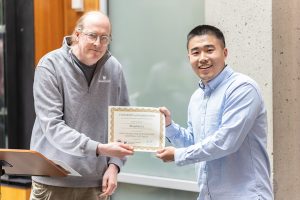
UW ECE and Allen School Professor Joshua Smith presents the Yang Award for Outstanding Doctoral Student certificate to Bingzhao Li at the 2023 UW ECE Awards ceremony.
In June 2023, Bingzhao received the Yang Award for Outstanding Doctoral Student at UW ECE for his research in optics and photonics. The Yang Award recognizes a UW ECE doctoral student in their final year of study who has conducted outstanding research in the field of electrical and computer engineering as evidenced by their publications or recognized by outside researchers in the field.
The Yang Award was established by successful entrepreneur and former UW ECE faculty member Andrew T. Yang, who has been one of the most influential people in the electronic design automation industry for nearly three decades. Yang is known for being a visionary in both research and entrepreneurship. The purpose of the award is to recognize and encourage outstanding doctoral student research contributions to the field of electrical engineering. The award goes to one qualifying student per year and is open to all doctoral degree candidates in UW ECE. Receiving the Yang Award is considered a high honor and helps to create career opportunities for the recipient.
“This award was really important to me in that it recognized my work and what I did during my doctoral studies,” Bingzhao said. “It gave me the confidence to realize that I’m doing something that matters. It also helped to expand my vision for what my career could be. Before receiving this award, I was focused solely on a future in academia, but now I’m thinking about building a startup and pursuing other opportunities in industry as well.”
Integrated photonics and acousto-optics
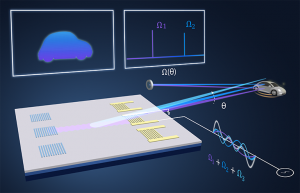
A significant outcome of the research for which Bingzhao Li received the Yang Award was an on-chip light detection and ranging (LiDAR) system he developed alongside UW ECE graduate student Qixuan Lin, with guidance and oversight from UW ECE and Physics Professor Mo Li. The computer chip the team developed uses sound waves running over its surface to steer a laser beam like a searchlight, so self-driving cars can detect and discern faraway objects, such as pedestrians and other vehicles. Illustration by Bingzhao Li and Qixuan Lin.
Bingzhao’s doctoral work at UW ECE was focused on integrated photonics, which is an emerging area of scientific research that uses light instead of electricity as a medium to transmit and process signals on flat surfaces, such as that of a computer chip. He also builds integrated acousto-optic devices, which use sound waves to manipulate light. And Bingzhao’s work in these areas is already having an impact, early on in his career.
For example, a significant outcome of the research for which Bingzhao received the Yang Award was a new type of light detection and ranging, or LiDAR, system he developed alongside UW ECE graduate student Qixuan Lin, with guidance and oversight from Professor Li. LiDAR is a 3D-imaging technology often used in self-driving cars to discern and distinguish objects in their path, including pedestrians and other vehicles. This new type of LiDAR system uses a scanning laser beam, and it could help self-driving cars “see” distant objects with much better clarity and precision. The system can detect and image objects from over 100 meters away.
At the core of this innovation is a laser beam-steering device that is roughly 1,000 times smaller than its counterparts currently in the marketplace. It is integrated into a computer chip, which makes it compact, sturdy, relatively easy to fabricate and cheap to produce. It also has a wide range of other potential applications, including use in robotic systems found in agriculture, global supply chains, and medical imaging.
To achieve this tight, on-chip integration, Bingzhao and the research team developed an innovative technique called “acousto-optic beam steering” for guiding the scanning laser beam by sending sound wave pulses across the surface of the computer chip. The sound wave is similar to what is used in filters for wireless communication, and it has a very high frequency of a few gigahertz, which is inaudible to the human ear.
“At a quantum physics level, the particles in the sound waves (phonons) collide with the particles in the laser beam (photons) on the surface of the chip, and their energy combines,” Bingzhao explained. “We precisely adjust the frequency of the sound waves to direct the beam into different directions in the free space above the chip and far into the distance.”
This new LiDAR system has been reported in a paper in the journal Nature and featured in media outlets such as GeekWire. It also recently made the cover of the September issue of Laser Focus World. Bingzhao has also made significant contributions to other research areas over the course of his academic career, including creating a new optoelectronic probe for neural engineering and contributing to notable developments in optical computing and quantum computing.
Mentorship and the benefits of diversity
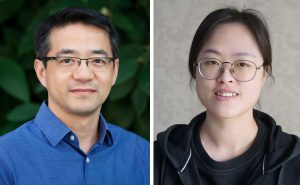
UW ECE and Physics Professor Mo Li (left) and UW ECE graduate student Qixuan Lin (right)
Bingzhao said that Professor Li’s guidance and mentorship over the years, from the University of Minnesota to UW ECE, has been crucial to his success.
“Professor Li is really smart and talking to him is easy. He loves sports, so our conversation is not limited to research. And during times when I struggled, he always gave me good advice,” Bingzhao said. “I enjoyed my doctoral studies, and he was always there for me, no matter the research or life difficulties I faced. He was there to help.”
One important way Professor Li helped Bingzhao was by teaching him better ways to deal with the inevitable and frequent failures that come with research experiments. Instead of letting these failures derail carefully structured plans, Bingzhao learned, under Professor Li’s guidance, how to see failure as an integral part of the research process. Bingzhao found that if he simply rethought his approach and tried something new in the moment, rather than considering his experiment a complete failure, he would very often achieve success soon afterwards. This adjustment to his working style made his overall approach to research and his studies much more efficient and productive.
Professor Li also inspired Bingzhao to think about why he began studying engineering in the first place — for the sheer joy of it.
“We can do a lot of things with light and sound, and they are all interesting. So, I’m curious about where we could go with this. For me, doing research is all about creating happiness, and this subject is something I really enjoy.” — Bingzhao Li
“Professor Li reminded me that science and engineering is about learning. I needed to focus on the experiment I was doing and choose to learn, no matter what might happen,” Bingzhao said. “By following his guidance, I found that every time I solved a small problem, I would get excited. This really makes me happy, even though there are a lot of tasks and difficulties in the research. In the end, publishing in a journal is always good, but I’ve learned that I gain the most happiness before that, in the day-to-day process.”
The breadth of courses and diversity of people and experiences at UW ECE have also contributed to Bingzhao’s personal and professional development. He noted that many of his classmates in China followed an academic path that was very similar to his own. But when he came to America, and, in particular, when he came to UW ECE, he was pleased to find a wide variety of different types of courses offered at the University, as well as people from diverse backgrounds and points of view. Bingzhao said that his experience at UW ECE has enriched his life and informed his research, providing new and different perspectives for him to consider.
Beyond research and academics, Bingzhao enjoys outdoor activities, such as hiking, and sports, especially basketball. He has participated in intramural basketball games at the UW, and tournaments through the Chinese Students and Scholars Association.
Looking toward the future
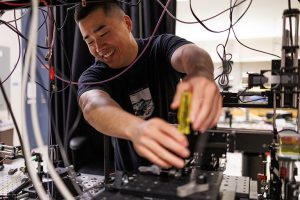
Bingzhao Li working in the UW Laboratory of Photonic Systems
Bingzhao plans to continue in his role at the UW Laboratory of Photonic Systems and work with Professor Li on commercializing the LiDAR system they invented. Their research team is already off to a strong start and has garnered support from UW CoMotion and the Washington Research Foundation, as well as major institutions, such as the Defense Advanced Projects Research Agency, or DARPA, and the National Science Foundation. Bingzhao and Professor Li are currently working on creating and field testing an engineering prototype for their LiDAR system, which is a project they estimate will take about one to two years. They are also looking into creating a startup company for the technology.
Beyond work at the lab and the LiDAR project, Bingzhao said that he is looking forward to new developments in augmented reality and virtual reality, where he believes integrated photonics will play an important role in the coming years.
“Light is amazing, and there are lots of things you can do with it, especially in integrated photonics. We can use our on-chip devices to slow it down, manipulate it with sound, play with it in an interesting way, and take it in whatever direction we want,” Bingzhao said. “We can also use light for imaging applications and help you to see the world in ways you never could before. We can do a lot of things with light and sound, and they are all interesting. So, I’m curious about where we could go with this. For me, doing research is all about creating happiness, and this subject is something I really enjoy.”
Visit the UW Laboratory of Photonic Systems website for more information about the research described in this article.

